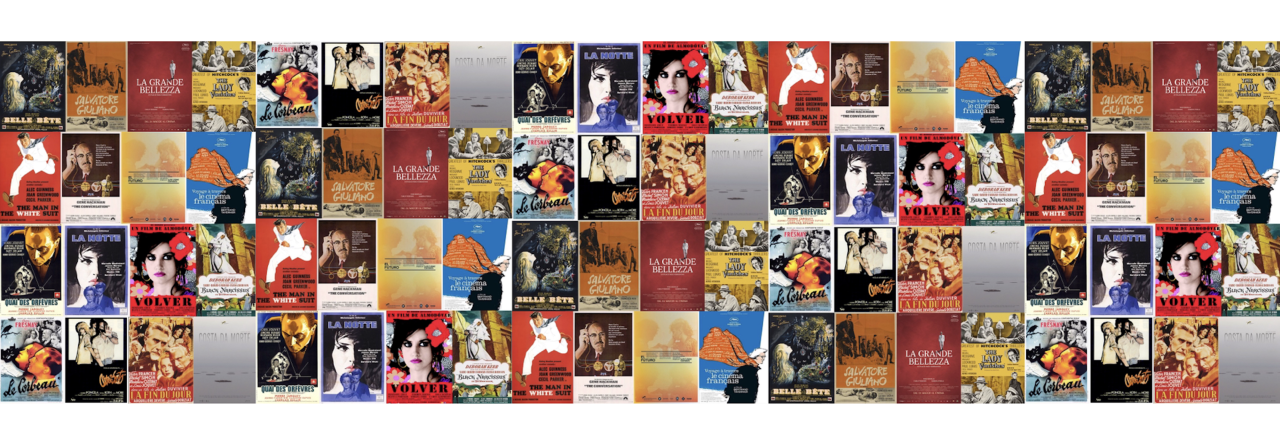
Director: Carlos Saura
Screenplay: Carlos Saura, Angelino Fons, and Rafael Azcona
Cast: Geraldine Chaplin, José Luis López Vázquez, Alfredo Mayo.
Synopsis: Julián’s childhood friend Pablo returns to their hometown with his new wife, Elena. Julián becomes obsessed with Elena, who reminds him of a woman he saw beating a drum during the famous Holy Week ritual in Calanda. Although rebuffed, Julián continues his pursuit while simultaneously remodelling his assistant, Ana, in her image.
Link: My original post on the film, from the old version of the blog.
Peppermint frappé is dedicated to Luis Buñuel (and there is a lot of Buñuelian sexual fetishising going on) but the director who most sprang to mind from the opening credits – with Julián (José Luis López Vázquez) assiduously cutting out images from women’s fashion magazines and pasting them into a scrapbook – was Pedro Almodóvar. Except, of course, Pedro’s career didn’t start until more than a decade later. Obviously Buñuel also had a strong influence on Almodóvar, but the central conceit of Peppermint frappé – a man is driven mad by jealousy and sexual obsession, and attempts to mould one woman into the image of another before moving on to murder – and the way in which the women are effectively reduced to the accoutrements of femininity (false eyelashes, lipstick, lace stockings), struck me as being particularly Almodóvarian. I wasn’t expecting to see connections between Saura and Almodóvar because they’ve always seemed to me to be very different filmmakers in both style and content, but it would appear that their common influences allow for some crossover.
The film marks Saura’s first collaborations with two actors who would be key figures in his films of the next 10-12 years: José Luis López Vázquez and Geraldine Chaplin. I personally think that López Vázquez’s best performance for Saura is in La prima Angélica (1974), but he is never less than great. Longstanding director/actor collaborations – and the idea of directors having what the Spanish call an actor fetiche (not necessarily a lead actor, but an indispensable member of the director’s habitual team) – often receive a lot of critical attention, but I have yet to encounter any writing that specifically examines the Saura/Chaplin films from that perspective. Chaplin and Saura’s professional (and romantic) relationship lasted for eight films: Peppermint frappé, Stress es tres, tres (1968), La madriguera (1969), Ana y los lobos (1973), Cría cuervos (1976), Elisa, vida mía (1977), Los ojos vendados (1978), and Mamá cumple 100 años (1979).
Peppermint frappé forms a trilogy of sorts with the pair’s two subsequent films – Stress es tres, tres and La madriguera. Collectively the three films explore dysfunctional relationships, with the later two focussing on duplicitous games between husbands and wives. But this first film also begins the recurring motif of Chaplin playing multiple women within the same film, or multiple versions (either real or imagined) of the same woman – this is a common thread across most of the films she made with Saura. Here she plays three characters within the narrative: Elena, the new wife of Julián’s boyhood friend, Pablo (Alfredo Mayo); Ana, Julián’s assistant in his medical practice; and the unnamed woman in Calanda, who made such a powerful impression on Julián. The last woman is ‘performed’ (or impersonated) by both Elena and Ana in different contexts, but Chaplin delineates all three women through her performance(s) – body language, voice, facial expressions – as well as costume.
Watching the film again, four years after the first time, there were a couple of things that stood out. I was struck by how spiteful Pablo and Elena are to Julián; the sly digs are there from the start, but before long they openly mock him and his foibles. Also, the degree of manipulation being applied to Ana is more open to interpretation than I remembered: she knows that she is being shaped to resemble someone else, and by the end of the film is complicit in her transformation (and Julián’s other actions). Chaplin often portrays a kind of ‘new woman’ in the Saura films, and her foreignness (or non-Spanishness) is key to how he positions her as representing the arrival of modernity in Spain – highlighting the resulting discord when the modern is juxtaposed with the social norms favoured and promoted by the Franco regime. Her characters are often disruptive forces within male worlds, and the three women she plays in Peppermint frappé encapsulate certain elements that she and the director would refine over time. The film also shows Saura’s aptitude for experimenting with style and pace – it is very different to the three films that precede it, although certain elements are constant (e.g. the elegance with which he frames actors within defined spaces within the frame – windows and mirrors are frequently used in this film – and the centrality of music as expression of character).



